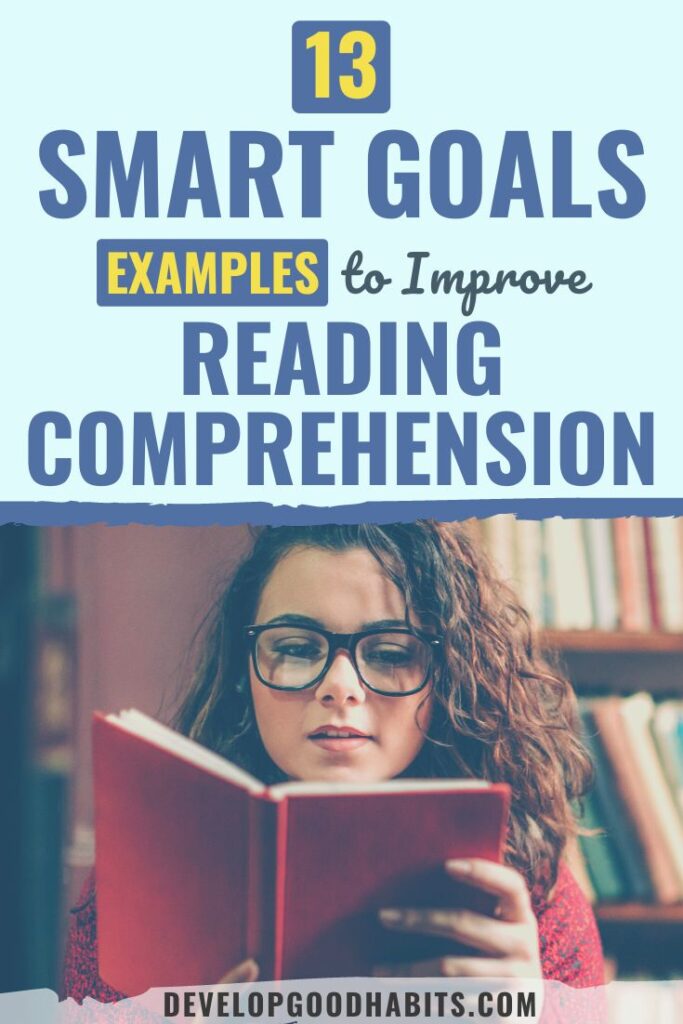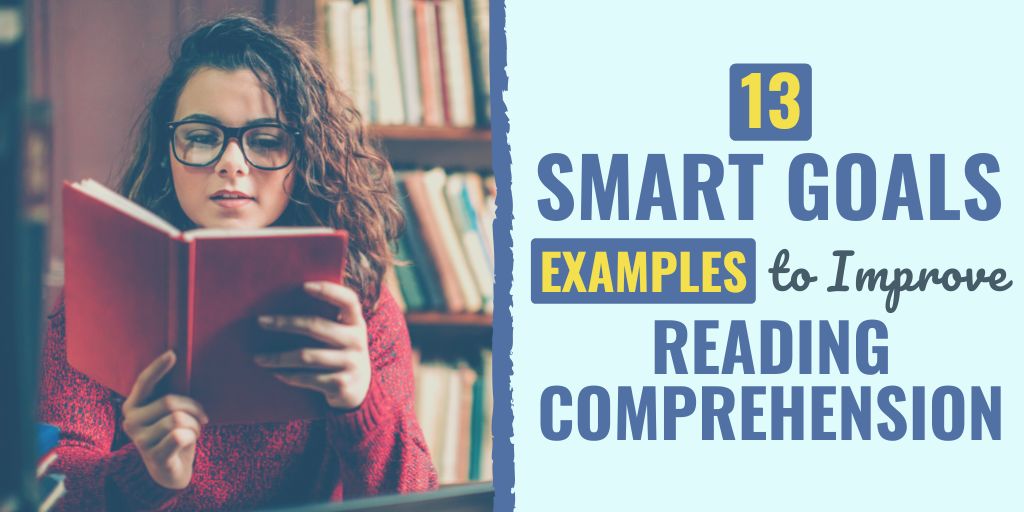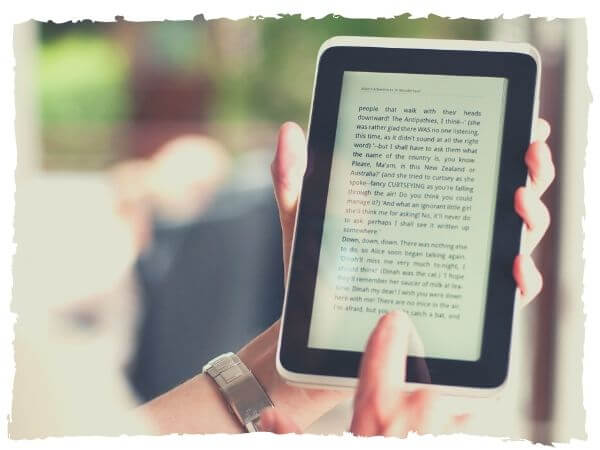There might be affiliate links on this page, which means we get a small commission of anything you buy. As an Amazon Associate we earn from qualifying purchases. Please do your own research before making any online purchase.
Do you find yourself reading the same passage of text over and over again, only to feel it fly right over you?
If so, then you might need help with your reading comprehension.
Reading comprehension adds meaning to what you are reading. Without it, the ideas, concepts, and thoughts you read on a page are just meaningless words. With proper comprehension, reading becomes informative, fun, and enjoyable.
Reading comprehension is a skill that you need to succeed in life. It’s also a skill you should learn whether or not you’re still in school. In fact, reading comprehension is a skill that requires continuous improvements throughout our lives.
One strategy that can help is to set and achieve SMART goals related to reading comprehension.
So with that in mind, let’s briefly define the SMART goals concept and then we’ll cover thirteen examples you can use to improve your reading comprehension.
What are SMART Goals?
Goals motivate us whenever we are running low. Having a goal gives us a direction to work towards in both personal and professional lives. They push us forward and repeatedly remind us of what we want to achieve.
Humans have been setting objectives and achieving them throughout history. In the 19th century, philosophers began to notice that many people were failing in achieving their objectives. They did not fail because they lacked energy or motivation, but rather because they could not keep themselves focused on their objectives.
But it was not until November 1981 that the term “SMART goals” was coined by George T. Doran. SMART goals enabled us to define our objectives in a more meaningful and organized manner, which helped us focus on what we wanted to achieve. With a narrowed-down focus on our objectives, our chances of achieving them increased multifold.
SMART is an acronym that claims that every goal we set should have five characteristics:
- Specific: The objective has to be narrowed down and clearly defined. It should focus on a specific and small area for improvement.
- Measurable: The goal must be linked to measurable criteria, which means there should be some indicator to indicate your progress towards the goal.
- Attainable: The goal must be something that we can achieve. The bar should not be set too high, and someone must have accomplished something similar in the past.
- Relevant: The goal must have a significant value in your life, and you should have a burning desire to achieve it.
- Time-Bound: The goal must be linked to a deadline, such as a date when you want to see yourself as having accomplished the goal.
Setting SMART goals is not too complicated, especially when you know the necessary tricks and tools. Our Ultimate Guide to SMART Goals is an excellent guide to get you started and makes setting and achieving your goals much easier.
Why Are SMART Goals Important for Reading Comprehension?
Countless studies and research have shown that we spend most of our lives on auto-pilot mode, hopping from task to task, every day, every night. We remain busy throughout the day and yet feel less and less accomplished every day. We never seem to have enough time and yet feel we are not doing enough.
Unfortunately, most of us like to live in our comfort zone, even if that means NOT planning or setting goals for the future. Statistics show that more than 80% of us don't even bother to define our goals. We often wish we had something or reached some position but never actually work towards it.
Most of us don't set goals simply because we are lazy. Others, because they are so pessimistic, doubt their capabilities to achieve what they are striving for.
A major reason for not achieving what you desire is failing to establish it as a goal. Once you have set your objective, only then can you begin to work towards it. If you don't have a direction, you will go in all directions and reach nowhere.
Those who fail after setting a goal have often set a goal that is too vague, unrealistic, or sometimes even irrelevant to them. Goals such as “I want to be better at reading comprehension” are vague and do not define the direction you want to take to achieve it. Since the goal is unclear, it will probably end up in the drawer and on the “things I hope to do someday” list.
Setting SMART goals for reading comprehension will help you define your ideas and objectives beforehand. Once you have a clear vision of what you want to achieve, you will find staying focused on the goal much easier.
We all have to deal with multiple tasks daily, and it is easy to forget about working on improving our reading comprehension on a daily basis. However, a SMART goal can be broken down into smaller tasks to allow you to set and achieve a milestone every single day.
SMART goals for reading comprehension will give you direction and allow you to focus on your objective. You can keep your daily milestones in mind whenever you read something throughout the day.
So let’s review those thirteen examples…
13 SMART Goals Examples for Reading Comprehension
1. Improve Vocabulary
“I want to improve my vocabulary to better understand what I am reading. I will try to learn five new words every day. Whenever I come across a word, I will look up its definition and then use it in a sentence to understand its meaning. “
S: Improve vocabulary by learning five words daily
M: Five words daily allows you to measure your progress daily
A: The goal is achievable if the steps of searching for a definition and using it in a sentence are followed
R: I want to better understand what I am reading, and vocabulary is a crucial factor in reading
T: One day is the deadline for five words
2. Break Text Up into Chunks
“I will take a break of two minutes after every fifteen minutes of reading. Instead of going on continuously, I will give my mind some time to absorb the information I have read. I will gradually increase my continuous reading time from fifteen minutes to thirty minutes in the next fifteen days by adding one or two minutes every day. “
S: Break up large bodies of text into smaller passages to understand them better, and increase continuous reading time to thirty minutes
M: A break of two minutes after every fifteen minutes. Increase reading time to thirty minutes
A: The goal is achievable because I am making small improvements every day
R: I want to make sure that I understand what I am reading, and giving myself breaks will allow my mind to refresh and grasp information better
T: The deadline for taking a break is fifteen minutes initially. This will be increased to thirty minutes over fifteen days.
3. Information Overload
“To keep myself focused on what I read, I will limit myself to reading 5,000 words per day. I will gradually increase the word count to 15,000 words per day over the next 30 days. “
S: I want to read 5000 words per day to keep myself focused
M: A daily goal of 5000-15000 words will allow me to measure my progress
A: Allowing myself to build the habit of reading gradually will make me better at understanding what I read
R: I want to make sure that I understand what I am reading, and reading too much can cause me to lose concentration.
T: The deadline for reading 5000-15000 words is one day, and for building the habit is 30 days.
4. Summarize
“I will summarize whatever I read. I will write a 50-100 words summary after reading approximately 2000 words or after every fifteen minutes. I will consciously practice this for 30 days, and it will help me build a habit of focusing on what I am reading. “
S: Write a summary to make sure that I understand what I am reading
M: I will write 50-100 words after every 2000 words
A: The goal is achievable as writing a summary should not be too difficult after reading
R: I want to make sure that I understand what I am reading, and summarizing the passage will ensure that
T: The deadline for starting a summary is fifteen minutes, and for building the habit is 30 days.
5. Skim and Prepare
“I will skim through the headings and the passage before reading to understand what I am about to read. I will write down three questions that I am looking to get answered from the text before I begin reading. I will practice this habit for the next 30 days. “
S: Write questions regarding expectations from the text
M: I will derive three questions from the passage I am about to read and will continue skimming until I get three questions
A: The goal is achievable as skimming through the text will give me an idea of the context and what I am going to read about
R: I want to make sure that I understand what I am reading, and having questions beforehand will keep me more focused because I will be searching for answers
T: The deadline for building this habit is 30 days
6. Reading Aloud
“I will practice reading at least 1500 words aloud every day. This will help me slow down and break my habit of skipping over words. I will carry on this practice for 15 days. “
S: Read 1500 words aloud every day
M: 1500 words aloud per day
A: The goal is achievable because reading aloud will stop me from skipping words
R: I want to make sure that I understand what I am reading, and reading each word can help me understand what I am reading
T: The deadline for 1500 words is one day, and for breaking the habit of skipping words is 15 days
7. Ask Questions
“I will practice taking a break after reading for 15 minutes, ask myself questions like “What did I read about?” and try to define what I read in my own words.”
S: Ask a question about what I read after every fifteen minutes
M: One question for every fifteen minutes of reading
A: The goal is achievable because recalling 15 minutes' worth of reading should be challenging but not impossible
R: I want to make sure that I understand what I am reading, and asking questions will ensure that I understand what I am reading
T: The deadline for one question is fifteen minutes
8. Reflection
“I will try to recall at least three ideas from what I read during the day. Thinking about what I read will help me retain the text and will help me understand it better. I will build a habit of this over the next 15 days.”
S: Recall three ideas from what I read after a few hours
M: If I am unable to recall at least three ideas, it means that I will have to reread the text
A: The goal is achievable because recalling three ideas should not be too difficult if I understood what I read
R: I want to make sure that I understand what I am reading, and pondering over what I read will ensure that I understand it better and retain it longer
T: The deadline for three ideas is one day, and for building the habit is 15 days
9. Highlight Text and Take Notes
“I will read with both a highlighter and a pen, starting with the next book I read and continuing for twenty books. As I read, I will highlight important lines and take notes regarding my thoughts and what I consider important. I will also write questions to investigate in future passages. I will use these items to review my comprehension at the end of the book by having a friend quiz me on this matter. “
S: This goal is very specific. You mention exactly what you plan on doing while reading and how you will gauge the effectiveness afterward. You also mention how many books you will do this for. You also mention what details you will focus on.
M: You can easily determine whether or not you followed this plan and for how many books. The ending quizzes will let you know how well the process worked.
A: This goal is completely achievable as all you need to do is be prepared with a highlighter, paper, and a writing tool.
R: Studies show that when you highlight things or take notes while reading, your brain retains the information better. This finding makes the goal completely relevant to reading comprehension.
T: This is a time-bound goal even though it doesn't specify an amount of time. It does mention the next book and how many books following that one, which satisfies the time-bound criteria.
10. Retell the Information to Someone
“If I can retell what I learned in my own words in a way that someone else understands, I will know I understood the material. With this in mind, I will enlist the help of a friend or family member who will listen as I relate the information and have them ask questions where they need to. I will know I succeeded when I can answer the questions for the next 50 books I read.”
S: This is specific in that you list what you will do, how long you will do it, and why you are doing it.
M: This goal is measurable in that you can keep a tally sheet that either lists the books you have read or you can keep a simple tally sheet of the number of books you have retold.
A: As long as you find someone who is willing to listen and ask questions, this is an attainable goal.
R: If you can tell someone information in a way that they understand, you have fully grasped the information. That makes this a relatable goal.
T: By stating you will do this for 50 books, you make this a time-bound goal.
11. Try Online Reading Games
“I will look for an online reading comprehension game online over the coming month. When I find one that will increase in difficulty as I get better, I will use it for an hour each day. I will be able to gauge my success by my progress through the levels of difficulty. I will continue to use this game daily until I have fully mastered it.”
S: This goal lists a specific type of game you will be looking for and what features, such as the increasing difficulty, it must have. You also list how long and how often you will play it. All this makes the goal specific.
M: The nature of the game makes your progress measurable. You can also keep track of what days you actually play and for how long, which makes it measurable.
A: With the variety of games out there, finding one that fits your criteria is achievable. With some scheduling and dedication, you can easily attain this goal.
R: Often, games make learning easier. With the game actually keeping track of your level, you will be able to see the progress you make in achieving the goal and your reading comprehension will increase over time.
T: You have made this time-bound by giving yourself a time limit on how long you will search for the game. The ending isn't a specific date, but you state when you have mastered all the levels as the ending point, which makes this fit the time-bound criteria.
12. Create a Reading Nook
“I will create a special area made only for reading over the coming week. It will have comfortable seating, good light, and everything I need for highlighting and enjoying the books I read. I will not allow phones or other distractions in this area, so I can concentrate fully on the material that I am reading. This will send a message to my brain that when I am in this area, it is time to read. I will be able to see if this strategy works by comparing comprehension tools like answering questions and writing a synopsis of what they are now to what they become when reading in this nook.”
S: This goal is specific. You mention what you are doing, what will be available to you, and what you will eliminate from the area. You also mention why you are doing this.
M: You will be able to measure your success by whether or not you create the area and eliminate distractions. You also include a way to gauge your success.
A: As long as you set clear boundaries and enforce them, this is a very attainable goal.
R: Eliminating distractions is essential for comprehension. Having a set area for reading only is also a great way to send a signal to your brain that this is the activity it needs to fully focus on.
T: You have given yourself a week to get this area in place which makes this a time-bound goal.
13. Connect New Knowledge with Current Knowledge
“Starting with my next book, I will write down what I know about a subject before I open a book. If I can relate it to personal experience, that will help me. I will then sit down after reading and write down what new information I learned. Lastly, I will write any unanswered questions and look for the answers online. By doing this for 20 books, I should be able to increase my concentration as I read. I will reward myself for completing 20 books by enjoying a trip to my favorite place of entertainment.”
S: You make this very specific by listing exactly what you will do, how you will go about testing yourself, how you will follow up, and how you will reward yourself.
M: This goal is measurable in that you can tell whether or not you followed the process you outlined and can easily keep a tally sheet of the number of books you did it for.
A: This is a goal that requires no outside influence, so it is perfectly attainable.
R: Relating new information to information you understand makes the new information easier to retain and understand, so this is relatable to your ultimate goal of increasing reading comprehension.
T: You make this timely by stating the number of books you will follow the procedure with.
Final Thoughts on SMART Goals for Reading Comprehension
Reading is not about going over the words. It is about learning, thinking, and reflecting on what you read. Passages of texts can transform into thoughts and ideas when read with proper comprehension; otherwise, they are mere chunks of the alphabet.
The key to accomplishing SMART goals for reading comprehension is to have them written down and revisit them every day. So if you want to take immediate action on this concept, then be sure to check out our 13-step process for setting SMART goals and also download the worksheet that we link to on this page.
And if you want more SMART goal ideas and examples, be sure to check out these blog posts:
- 6 SMART Goals Examples for Improving Your Writing Skills
- 6 SMART Goal Examples for ADHD Students
- 23 Goal Ideas to Set and Achieve for a Better Year
Finally, if you want to take your goal-setting efforts to the next level, check out this FREE printable worksheet and a step-by-step process that will help you set effective SMART goals.





